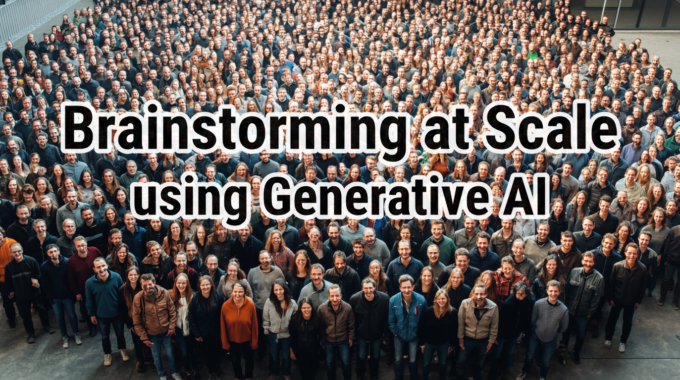 I think about slime mold a lot. And fish. And birds. And all other social creatures that have evolved to amplify their collective intelligence by collaborating in closed-loop systems. We have many names for these natural systems, including flocks, schools, shoals, blooms, herds, and swarms. In all cases, these collaborative behaviors emerged over time because the groups, when acting together as coherent systems, proved better able to solve problems, make decisions, and ultimately survive.1,2
I think about slime mold a lot. And fish. And birds. And all other social creatures that have evolved to amplify their collective intelligence by collaborating in closed-loop systems. We have many names for these natural systems, including flocks, schools, shoals, blooms, herds, and swarms. In all cases, these collaborative behaviors emerged over time because the groups, when acting together as coherent systems, proved better able to solve problems, make decisions, and ultimately survive.1,2
Which is why I’ve been fascinated by the prospect of bringing this type of intelligence amplification to us people. No, I’m not talking about “crowd sourcing” or “polling” or even “prediction markets” which sequentially aggregate input from large numbers of individuals. Those methods certainly have value, especially when it comes characterizing populations, but they’re don’t create synchronous closed-loop systems in which the participants pool their intellects in real-time, forging an emergent unified entity.
What I’m talking about is “swarm intelligence” – the ability of a group of individuals to attack a problem in synchrony, the participants interconnected by real-time feedback loops that allow for collaborative decisions and actions. I’m talking about a process wherein the unified swarm can significantly outperform the individuals who comprise it. The process is complex and yet it evolved repeatedly over the eons, not just across species, but across kingdoms, from single celled organism like slime molds, to social insects like bees and ants, to vertebrates like fish and birds. Even algae blooms have been shown to demonstrate swarm intelligence.3,4
Consider the humble Slime Mold – It’s a single celled organism that congregates in massive numbers (millions) to form a super-cell, all sharing a cell wall and all operating as a unified entity. And although the single cells are extremely simple, the unified entity can successfully forage woodlands for rotting vegetation. In fact, slime molds have been shown by researchers  at Hokkaido University in Japan to be able to navigate mazes, finding the shortest and most efficient route between two points of food.5,6 In other words, as a unified swarm these very simple cells display collective intelligence that exceeded any of the individuals. The same benefits are seen in fish and ants and birds. But what about people? We don’t have the natural ability to pool our intelligence in swarms.
at Hokkaido University in Japan to be able to navigate mazes, finding the shortest and most efficient route between two points of food.5,6 In other words, as a unified swarm these very simple cells display collective intelligence that exceeded any of the individuals. The same benefits are seen in fish and ants and birds. But what about people? We don’t have the natural ability to pool our intelligence in swarms.
But what if we could swarm? Would the resulting collaborative entity have enhanced intelligence? This question was purely theoretical until last year when a new social networking tool called UNU began alpha testing. UNU is the computational glue that allows people to come together into artificial swarms, creating group intellects that can answer questions, make decisions, ponder ideas, even express opinions. And thus far, the results have been fascinating.
Over the last few months we’ve pitted artificial human swarms against a few well-known problems: predicting the NFL playoffs, predicting the Golden Globes, predicting prop bets for the Super Bowl, and most recently predicting the top 15 awards in the 2015 Oscar competition. And in all cases, the swarm intelligence greatly exceeded the ability of the individuals. In fact, the swarm did better than even the most skilled individual. The swarm intelligence also exceeded the average “votes” given by the group of individuals, thus beating the traditional methods of characterizing populations. In short, testing so far has shown that bringing people together in a real-time dynamic system has great benefits.
To quantify, we compared SWARMS to traditional polls in our most recent set of tests. When predicting the outcome of the 2015 Academy Awards, we polled 48 individuals, asking them to predict the top 15 questions. Taking the most popular predictions as a representation of the “wisdom of the crowd”, the group collectively made 6 correct predictions out of 15 attempts (40% success rate). We then took a 7 person sub-group of that 48 person population and asked them to make the same predictions, but now as a unified dynamic system (a swarm). These individuals were average performers within the group of 48 (on poll results), so we are certain not to have packed the swarm with unique individuals. And guess what happened…
When working as a swarm, these 7 individuals got 11 of 15 predictions correct (73% success rate). In other words, a sub-group that was only 15% the size of the full population had a success rate of 73%, substantially better than the 40% success rate of the larger group using traditional polling. We believe that doubling the accuracy of the predictions with a group that was only 15% the size is a remarkable result and speaks to the great promise of real-time human swarms.
We call these artificial human swarms “Social Swarms” and the UNU platform allows anyone to create their own, invite their friends and colleagues, and ask it whatever questions they’d like. If you’re curious about the details of any of the prior studies, you can read about them in our previous blog posts on the NFL PLAYOFFS, the GOLDEN GLOBES, the SUPER BOWL, and THE OSCARS.
Below is video that shows a Social Swarm in action. It’s comprised of 32 college students, all networked in real time, all answering the question: “What’s the best social network out there.” The entire process took only 26 seconds and yet it reveals fascinating insights in simple visual form. See the collective intelligence:
What about accuracy and intelligence of real-time Social Swarms? A good way to test a collaborative swarm is to pit it against questions that will ultimately prove to be either correct or incorrect. We recently did this with a number of high profile events, including the Oscars and NFL Playoffs. Below is a real-time social swarm that proved better at predicting the Oscars than most experts (including the New York Times):
And with a little extra processing, we can view this Collective Intelligence as a slime mold, exploring the decision space and converging upon a preferred solution. Check out this video…
However we visualize the data, early results suggests that Artificial Swarm Intelligence is achievable by using moderating software to create the feedback loops, (i.e. the UNU platform), thereby connecting groups of users into real-time dynamic systems. And just like natural swarms, these artificial swarms have the capacity to outperform the individuals who comprise it. And that makes good sense, for the benefits of swarming are as natural as, well… the birds and bees.
We believe this collaborative approach to artificial intelligence has many advantages, as expressed in prior blog posts, but most of all – the people who have participated thus far have said that social swarming is really fun. That might sound unimportant, but it’s very important, because for the technology of Collaborative A.I. to take off, lots of people need to participate. And now they can — anyone who wants to join an upcoming BETA can sign up by clicking here.
SOURCES
1: Deneubourg, J.L., Goss, S.Collective Patterns and Decision Making. Ethology, Ecology, & Evolution 1: 295-311, 1989
2: Axelrod R, Hamilton WD (1981) The evolution of cooperation. Science 211:1390–1396.
3: Amé JM; Halloy J; Rivault C; Detrain C; Deneubourg JL; Collegial decision making based on social amplification leads to optimal group formation. Proc Natl Acad Sci U S A 2006 Apr 11;103(15):5835-40
4: Group personality during collective decision-making: a multi-level approach, Proceedings of the Royal Society B, rspb.royalsocietypublishing.or… .1098/rspb.2014.2515
5: http://www.scientificamerican.com/article/brainless-slime-molds/
6: http://www.itsokaytobesmart.com/post/37228609143/beyond-their-pretty-remarkable-ability-to-think
7: “Haeckel Mycetozoa” by Ernst Haeckel – Kunstformen der Natur (1904), plate 93: Mycetozoa (Licensed under Public Domain)
Come see us at Collective Intelligence 2015




Pingback: Emergent Intelligence from a Jar of Beans - UNANIMOUS A.I.
Pingback: STAR WARS or STAR TREK, a swarm intelligence decides!
Pingback: BITCOINERS predict BITCOIN - UNANIMOUS A.I.
Pingback: SOCIAL SWARMS reveal trends and views - UNANIMOUS A.I.
This is a very interesting study method. I had no idea that people can be classified as a swarm. I learned quite a bit about how information is processed among people.